Occupational environment monitoring at the vegetable and fruit processing factory
99,000 ₫
Note: The above price is calculated for one sample, the price may vary depending on the area of the environment that needs monitoring and the movement of the market. For more accurate price support, please refer to the quotation table or contact directly with our consulting staff.
Environmental monitoring of a vegetable and fruit processing factory is a session of collecting, analyzing, and evaluating factors in the workplace that may harm workers health.
Table of Contents
Toggle1. Overview of the Vegetable and Fruit Processing Factory
a. What is a vegetable and fruit processing factory?
A factory for vegetable and fruit processing is a large-scale production facility designed and equipped with machinery, equipment, and technological systems to process, handle, and package vegetables and fruits. Its task is to transform fresh vegetables and fruits from farms or gardens into processed products such as canned vegetables, bagged vegetables, frozen vegetables, pureed vegetables, vegetable juices, and other related products.

b. Production stages in the vegetable and fruit processing factory
The production stages in a vegetable and fruit processing factory may include:
- Receiving and inspecting vegetables and fruits: Fresh produce is received at the factory and inspected for quality, with any substandard or damaged products removed.
- Washing and cleaning: Vegetables and fruits are washed to remove dust, residues, and other impurities. This process often involves vegetable washing machines and water systems.
- Processing and cutting into products: Vegetables and fruits are processed and cut into different sizes and shapes according to the final product requirements. Equipment such as cutters, grinders, peelers, and seed separators may be used during this stage.
- Heat treatment and packaging: Some vegetable and fruit products may undergo heat treatment such as boiling, steaming, or heating for preservation and shelf-life extension. They are then packaged in boxes, bags, or jars to maintain quality.
- Final quality inspection and packaging: Processed products are inspected for quality before final packaging and labeling. This ensures compliance with quality standards, food safety, and preservation requirements.

c. Machinery used in vegetable and fruit processing factories
Various types of machinery are used to increase productivity and efficiency in vegetable and fruit processing factories. Common machinery includes:
- Vegetable washing machines: Automatic or semi-automatic machines are used to clean vegetables and fruits from dust, residues, and bacteria.
- Vegetable cutters: Automatic or semi-automatic cutters are used to cut vegetables and fruits into different sizes and shapes, such as strips, slices, sticks, or pieces.
- Grinders: Grinders are used to puree vegetables and fruits into mixtures or powders, suitable for juice production, soups, or other dishes.
- Peeling machines: Automatic or semi-automatic peelers remove the outer skin of vegetables such as carrots, potatoes, and radishes, increasing productivity and reducing labor.
- Packaging machines: Automatic or semi-automatic machines are used to package vegetable and fruit products in boxes, bags, bottles, or cans, often with vacuum sealing to preserve quality.
- Quality inspection machines: Automatic or semi-automatic machines check parameters like size, color, ripeness, and weight to ensure products meet quality standards.
- Conveying and storage systems: Conveyor belts, transport systems, storage systems, and warehouses are used to move and store vegetables and fruits during production and preparation for delivery.

d. Occupational diseases for workers in vegetable and fruit processing factories
Workers in vegetable and fruit processing factories may suffer from some occupational diseases caused by environmental and work-related factors. Common occupational diseases include:
- Respiratory diseases: Workers may develop pneumonia, asthma, sinusitis, or allergic rhinitis from exposure to dust and vapors from vegetables and fruits, especially in environments with high levels of dust or fumes.
- Skin diseases: Prolonged contact with fresh vegetables and fruits may cause dermatitis, chapping, eczema, contact dermatitis, or skin allergies.
- Spinal and joint diseases: Tasks involving cutting, grinding, and processing vegetables and fruits may strain the spine and joints, causing back pain, spinal degeneration, and other joint problems.
- Eye diseases: Exposure to irritants such as fumes, particles, or dust may cause conjunctivitis, eye pain, irritation, and other eye issues.
- Hearing problems: Exposure to loud machinery and processing equipment noise can lead to hearing loss and tinnitus.
- Hand and neck disorders: Repeated use of tools like knives and grinders can lead to injuries and conditions affecting the hands and neck, such as periarthritis, joint degeneration, and carpal tunnel syndrome.
To ensure safety and protect workers’ health, personal protective equipment such as protective clothing, goggles, masks, and proper ventilation systems should be used. Additionally, occupational safety training and adherence to safe work procedures are crucial to reduce the risk of occupational diseases.

e. Popular vegetables and fruits on the market
Many vegetables and fruits are commonly used in cuisine and widely available. Popular ones include:
- Carrots: Orange in color, long in shape, used in stir-fry, roasting, salads, juice, and soups.
- Potatoes: Smooth-skinned, white or yellow, used in fries, roasting, steaming, stir-fry, soups, and potato dishes.
- Radishes: Includes varieties such as red, white, and purple radishes, used in stir-fry, soups, salads, or as spices.
- Chinese cabbage: Includes types like cabbage, bok choy, watercress, and leafy greens, used in stir-fry, soups, steaming, or boiled dishes.
- Onions: White or purple, with a distinctive flavor, used in stir-fry, soups, roasting, salads, and sauces.
- Chili peppers: Red, green, bell peppers, or jalapeno, used as spices in roasting, stir-fry, soups, sauces, and salads.
- Tomatoes: Red, round, used in stir-fry, soups, roasting, salads, sauces, and juice.
- Cucumbers: Round or elongated, green or light green, used in stir-fry, pickles, salads, or as seasonings.
- Cabbage: Green, red, or white varieties, used in stir-fry, soups, steaming, or boiled dishes.
- Eggplants: Small green eggplants, similar in shape to tomatoes, used in sauces, sweet-sour dishes, and vegetarian recipes.
2. Overview of occupational environment monitoring services
a. What is occupational environment monitoring in vegetable and fruit processing factories?
Occupational environment monitoring (or workplace environment measurement) in vegetable and fruit processing factories involves collecting, evaluating, and analyzing measured indicators of workplace environmental factors. This aims to implement timely measures, reduce environmental harm to workers’ health, and prevent occupational diseases. Monitoring is mandatory for vegetable and fruit processing factories.
Monitoring plays a crucial role in protecting and enhancing workers’ health because employees are the primary resource and directly contribute to the enterprise’s profit. Workers frequently exposed to hazardous factors beyond permissible limits may suffer health effects and develop occupational diseases.
REGISTER FOR OCCUPATIONAL ENVIRONMENT MONITORING SERVICE
b. Nam Viet’s occupational environment monitoring program
Nam Viet’s occupational environment monitoring program is developed by engineers specialized in occupational safety and environmental protection. Aiming to ensure workers’ health and safety, the program uses modern measurement methods to monitor air quality, water, microclimate factors, physical factors, dust, and more in the workplace. This program is crucial for ensuring a safe working environment and protecting workers’ health.
Additionally, Nam Viet’s program contributes to researching and developing new solutions to improve workplace environmental quality. With a dedicated and professional team of monitoring specialists, Nam Viet’s exclusive monitoring program represents a breakthrough in occupational safety management and environmental protection in Vietnam.

c. Standardization in workplace measurement procedures
Standardization in Nam Viet’s workplace measurement procedures is crucial for ensuring accurate and reliable results. The program follows recognized standards from the Ho Chi Minh City Department of Health. This ensures collected data can be reliably used to assess workplace conditions and make decisions to improve the work environment and protect employees’ health.
These standardized procedures also ensure measurements are conducted by highly qualified monitoring specialists with years of experience, enabling managers and experts to trust Nam Viet’s results and make accurate decisions.
By applying standardized procedures, Nam Viet demonstrates its commitment to providing a safe working environment, protecting employees’ health, and contributing to improving occupational safety and environmental management in Vietnam.
d. Reporting results of occupational environment monitoring in vegetable and fruit processing factories
Monitoring results are prepared according to Form No. 04, Appendix III issued with Decree 44/2016/ND-CP and prepared in two copies: one for the contracting enterprise and one retained by the monitoring organization.
The storage period for monitoring results is unlimited, in accordance with legal regulations.

e. Frequency of occupational environment monitoring according to the law
According to Clause 2, Article 18 of the Law on Occupational Safety and Hygiene 84/2015/QH13, employers must organize occupational environment monitoring to assess harmful factors at least once a year.
f. Deadline for submitting occupational environment monitoring reports according to the law
The deadline for submitting reports is before December 31 each year. Enterprises in production facilities must submit monitoring reports to the Department of Health in the locality where the business headquarters and employees are located.
When there are changes in technology, production processes, or facility upgrades that may introduce new hazards, enterprises must update occupational hygiene records related to harmful factors that require environmental monitoring.
g. Regulations on penalties for violations of occupational environment monitoring by employers
According to Article 27 of Decree No. 12/2022/ND-CP dated January 17, 2022, on administrative penalties in labor, social insurance, and Vietnamese employees working abroad under contracts:
- Clause 2: Fine of 2,000,000 – 5,000,000 VND for employers who fail to publicly disclose monitoring results to workers at the monitored site immediately after results are available.
- Clause 3: Fine of 20,000,000 – 40,000,000 VND for employers who fail to conduct occupational environment monitoring to control health risks as required by law.
- Clause 4: Fine of 40,000,000 – 60,000,000 VND for employers who collude with monitoring organizations to falsify monitoring activities but have not reached criminal liability.
3. Harmful environmental factors for workers in fruit and vegetable processing factories
When working in fruit and vegetable processing factories, workers may encounter several harmful environmental factors that can affect their health. Below are some environmental factors that may be harmful in the fruit and vegetable processing industry:
- Dust: The process of cutting, grinding, and processing fruits and vegetables can generate dust, especially when using machinery and processing equipment. Inhaling dust in the air can cause respiratory irritation and other respiratory problems.
- Chemicals: During processing, chemicals such as preservatives, cleaning agents, and treatment agents may be used. Long-term exposure to these chemicals can cause irritation to the skin, eyes, and respiratory system.
- Temperature and humidity: The working environment in fruit and vegetable processing factories can have high temperature and humidity. This can create discomfort and lead to fatigue and dehydration for workers.
- Noise: Machinery and equipment in fruit and vegetable processing factories can generate high levels of noise. Continuous and loud noise can cause hearing problems and stress for workers.
- Biological toxins: Fresh fruits and vegetables may contain bacteria, fungi, parasites, and other pathogens. Exposure to biological toxins can lead to infections and illnesses.
REGISTER FOR OCCUPATIONAL ENVIRONMENT MONITORING SERVICE
4. Measures to improve the working environment in fruit and vegetable processing factories
To improve the working environment in fruit and vegetable processing factories, the following measures can be applied:
- Dust management: Ensure machinery and equipment are regularly maintained and cleaned to reduce dust during processing. Use effective dust extraction systems to remove dust from the air.
- Chemical safety: Use safe chemicals and strictly follow proper usage procedures. Provide guidance and recommendations for safe handling, storage, and disposal of chemicals.
- Temperature and humidity control: Ensure the air conditioning system works properly to maintain comfortable temperature and humidity levels for workers.
- Noise reduction: Provide ear protection for employees working in high-noise environments. Implement and maintain soundproofing and insulation measures for machinery and equipment to reduce noise.
- Hygiene and food safety: Ensure hygiene and food safety by applying strict cleaning procedures, controlling bacteria, and maintaining the quality of processed fruits and vegetables.
- Training and awareness: Train employees on occupational safety, safe work procedures, proper use of protective equipment, and preventive measures against occupational diseases.
- Regular inspections: Conduct regular workplace inspections to ensure compliance with labor safety regulations and protect workers’ health.
- Promoting health awareness: Create a work environment that encourages employees to maintain a healthy lifestyle, including balanced nutrition and regular exercise.
- Periodically conduct occupational environment monitoring in factories, collecting and analyzing harmful factors for workers, and adjust to reduce risks to prevent occupational diseases.
5. Benefits of periodic monitoring in fruit and vegetable processing factories
An Toan Nam Viet provides enterprises with excellent benefits when using occupational environment monitoring services according to Decree 44/2016/NĐ – CP on managing and controlling harmful factors in the workplace that affect workers.
- Enterprises can proactively control harmful factors in workshops or factories.
- Receive recommendations on measures to reduce harmful factors and improve the quality of the working environment.
- Indirectly protect human resources, a key factor in enterprise development.
- Reduce the impact of occupational diseases on human health, thereby minimizing future treatment costs.
- Improve worker health, leading to better product quality and stable production output.
- Ensure compliance with labor safety regulations and avoid legal risks.
- Enhance credibility and professionalism in all aspects, elevating the enterprise’s brand.
Nam Viet’s environmental monitoring service is a solution to reduce the impact of occupational diseases, contributing to a healthy and quality working environment.

6. National occupational environment monitoring center
Nam Viet Occupational Environment Monitoring Center is a professional unit specializing in monitoring and measuring occupational environment quality across all provinces in Vietnam. With an experienced team of monitoring specialists, the center uses modern measuring equipment to ensure accuracy and reliability.
In addition to monitoring services, the center assists clients in planning, managing, and tracking occupational environment issues. With the motto “customer-centered,” the center prioritizes customer satisfaction, meets all client needs, and is committed to providing the best solutions for enterprises.
REGISTER FOR OCCUPATIONAL ENVIRONMENT MONITORING SERVICE
With investments in technology, equipment, and human resources, Nam Viet’s monitoring center has become one of the most reputable units in occupational environment monitoring in Ho Chi Minh City, with the following objectives:
- We always value our brand reputation and the quality of our service products.
- We provide clients with the best and most suitable solutions possible.
- Along with a team of experienced Masters and Engineers, aiming to protect the environment and benefit enterprises.
- By working with Nam Viet Environmental Monitoring Team, companies will receive professional service from experts in the field and enjoy the best cost advantages.
The occupational environment monitoring process at Nam Viet includes the following basic steps:
- Before monitoring, ensure all machinery and equipment are calibrated and adjusted according to legal regulations.
- Strictly follow the occupational environment monitoring procedures as committed to the Department of Health.
- Accurately report monitoring results to employers.
- If monitoring results indicate unsafe conditions for workers, Nam Viet will provide remedial solutions, and the workplace will implement the following:
- Implement measures to improve working conditions to minimize the impact of harmful factors and prevent occupational diseases.
- Organize health check-ups to detect occupational and work-related diseases early for workers in unsafe environments.
- Provide allowances in kind for workers according to labor law regulations.

7. Occupational environment monitoring service quotation
To help enterprises perform occupational environment monitoring professionally and effectively, Nam Viet provides clients with a detailed quotation for occupational environment monitoring services with quality and reasonable cost.
- Our quotation provides detailed pricing for the monitoring services we offer, including costs related to transportation, measurement, analysis, and reporting. Clients can fully trust the accuracy and reliability of the monitoring reports we provide.
- We are committed to offering the most competitive and reasonable prices on the market, and we are always ready to provide prompt and professional consultation on monitoring services.
- With Nam Viet’s quotation, clients can easily select service packages that meet their needs. We are committed to delivering the highest satisfaction with professional service quality.
1 review for Occupational environment monitoring at the vegetable and fruit processing factory
No comments yet

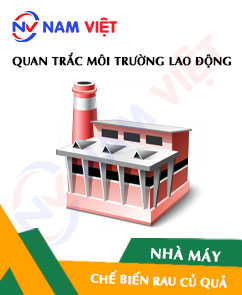
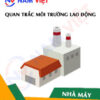
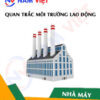
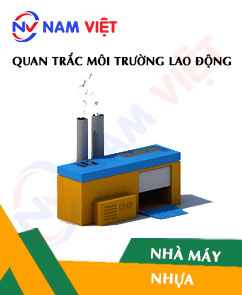






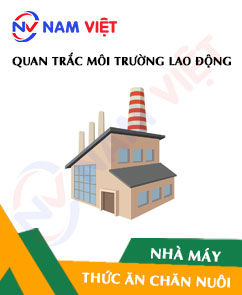
maituyet.cuong12
Good labor environment monitoring service!